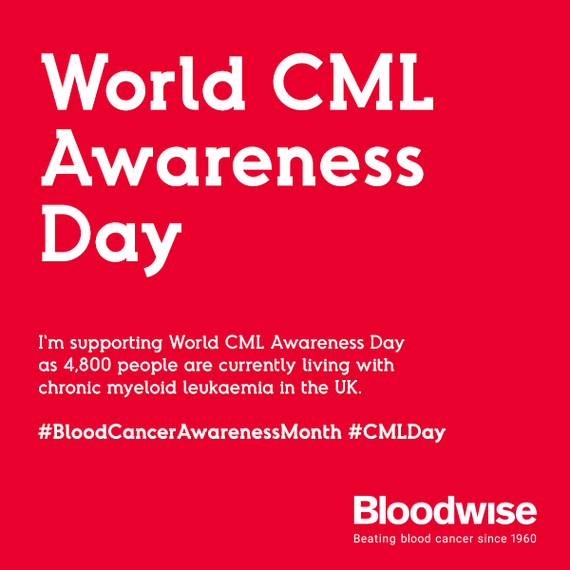
I've never been much of a fan of 'Awareness Days'. They all feel a little contrived and in recent years have been taken over by PR companies and agencies desperate to get people to buy products or sign up to events or activities they'd previously never given any real thought.
However there are some Awareness Days, and month's, which actually do mean something and are worth promoting. Friday 22nd September and World CML Day is one of these and this blog is dedicated to raising awareness about CML which is a type of blood cancer that I knew absolutely nothing about myself prior to my own diagnosis back in 2003.
I was 18 when doctors delivered the news that I had CML or chronic myeloid leukaemia to give it it's proper title although that meant little to me at the time. All I was able to take in was that I had cancer at the age of 18 just a week before I was supposed to start university and only a couple of months after my mum's diagnosis with terminal bowel cancer which I was still trying to come to terms with.
Signs, symptoms & diagnosis
Looking back all the symptoms that I know now are tell-tale signs of leukaemia were there for all to see. The trouble is that back then I had know idea what to look out for!
I had been suffering from headaches and general tiredness for months. I'd also begun to experience that head rush feeling you occasionally get when you stand up too quickly on a not infrequent basis. I also lost a bit of weight and was waking up in the mornings with my bed drenched in sweat. To cap it all off, my vision, which had previously been perfect, had begun to get a bit blurry. However, as a headstrong, stereotypical 18 year old boy, I failed to take heed of any of these signs and only agreed to go to a general MOT to get my Mum off my back, starting with an eye test.
Thank God I did as this kick started the whole process that unearthed my leukaemia before it was too late. The optician discovered that I had hemorrhaging in the back of the eyes and was rushed off to see the Eye Specialist at Kingston Hospital where several examinations and two blood tests later, my diagnosis was confirmed. I had blood cancer.
Initial treatment
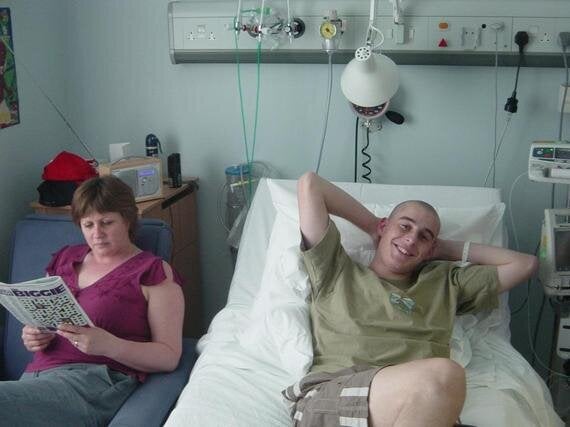
The doctors' first priority was to get my white blood cell count under control. A healthy person is supposed to have between 4-10 white blood cells per ml of blood. I had more than 100 and it was these excess white blood cells that were causing all my symptoms by slowing down my blood supply.
To remove these meddlesome excess white blood cells, I underwent a process called leukapheresis which involved an amazing machine that took the blood out of one arm, removing the excess white blood cells and then pumping the 'clean' blood back into my other arm. It only took a couple of hours and I have a strong memory of Andrew, the nurse overseeing the process, singing along to Missing by Everything But The Girl.
Following leukapheresis, I underwent my first bone marrow biopsy which all blood cancer patients will tell you is not something you'd ever want to endure unless you have to. The process involves doctors putting a giant needle into a bone in the lower portion of your back and extract a piece of bone marrow to run further tests on to identify the exact nature of the leukaemia and your bone marrow type.
I was then free to go home and only had to return to the hospital once a week for check-ups whilst the doctors scoured the bone marrow registers for a suitable stem cell donor as I made the decision to go for a transplant rather than try a new 'wonder drug' that was on clinical trial called Imatinib.
Preparing for transplant
To keep the blood cell count under control while I awaited news of a donor I was put on a mild form of chemotherapy in the form of a daily tablet called hydroxyurea. This killed off the excess white blood cells on their creation. My energy levels picked up immediately and I began to feel like a human being again.
It was a nervous wait in the end but shortly before Christmas I was told the news that a donor had been found and date of May 2004 set for the treatment to begin. This was a huge relief for us all especially my Mum, whose own condition had taken a turn for the worse. It was the first time in months she had something to smile about (although she was hiding her own suffering well) and our last Christmas together was a very happy one.
In the build up to the transplant I was determined to do everything that I could to ensure I had the best possible chance of the transplant being a success so I stopped drinking and going out late and, for the first time, I got into running long distances.
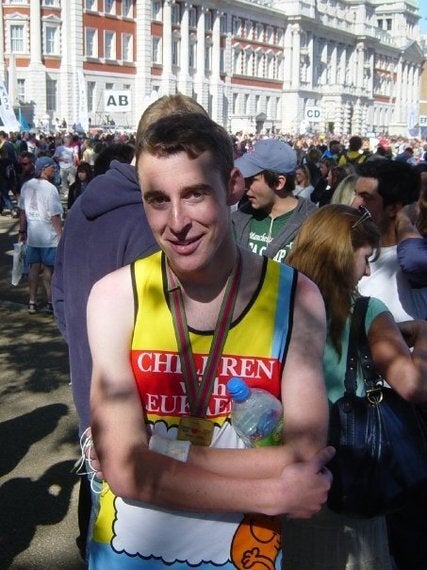
Running became my release providing me with valuable thinking time. I felt free of everything when I ran and this culminated in me deciding to enter the London Marathon which was something I had always wanted to do. I also decided to start raising money and awareness for leukaemia charities, pestering everyone I knew with sponsorship forms and putting collection buckets in all the local shops and cafes. The response was overwhelming and before I knew it we had raised £35,000!
I completed the marathon in just under 4 hours - ironically still one of my quickest ever marathon times! Achieving something positive during the most negative of situations was enormously rewarding and helped me to feel like I had ownership over my cancer rather than the other way round.
A week after the marathon I went in to the hospital to begin my treatment feeling fitter than I'd ever been in my life something which looking back I think really helped me for what was to come.
Chemotherapy
Treatment began with three days of intense chemotherapy followed by two days of radiotherapy to blast away any of the bone marrow that was left behind. The process was intense and it took a little bit of me with it. I remember feeling so, so tired - especially after the radiotherapy. At one point I even fell asleep watching the FA Cup Final. That had never happened before and it's certainly never happened since!
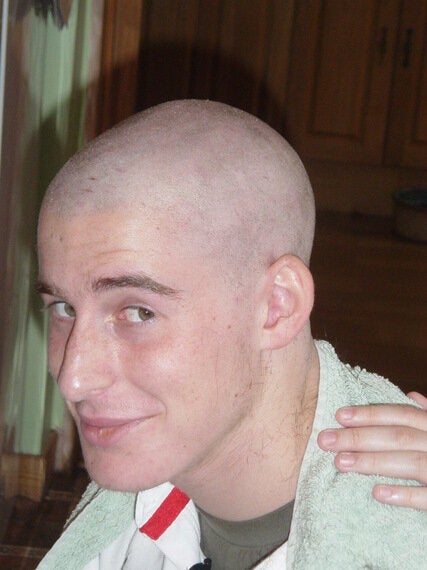
As expected, my hair began to fall out in clumps on my pillow and it was recommended that I get my head shaved. Apparently people's hair falls out because the chemotherapy is unable to distinguish between the cancer and other fast growing cells like hair or your cheek lining. I struggled to produce saliva and this made eating really difficult.
However, whilst this phase of the treatment was an ordeal, it was bearable thanks to the amazing nursing team. For every headache they had a pill to dull the pain and for every bout of nausea there was a drug that could take away my queasiness.
Transplant
The transplant itself was something of an anti-climax as the donor's bone marrow - the difference between you living and dying - looked like a bag of tomato ketchup! It took a lot of faith to think that one small bag of reddish solution was going to fill the gaps left behind by my bone marrow.
A nervy period followed as we waited to see if the donor marrow took hold and started to produce healthy white blood cells. Without question this was the most difficult time as I was effectively without an immune system where any infection could, potentially, have been too difficult for the body to overcome.
Looking back, I was scared. However, I kept a lot of my own feelings in check as my Mum's condition had deteriorated rapidly during my time in hospital to the point that it had become an ever more likely scenario that she would die while I was in hospital.
I did everything I could to try and hurry along the process, literally following everything the doctors told me to do to the letter. I brushed my teeth five times a day, drank more water than I've ever drunk and even got on an exercise bike and pedalled in my pyjamas for as long as my emaciated body could bare it. The doctors and the nurses were fantastic, too, and kept me going. Their expertise and my determination ensured that all our prayers were answered as I produced a white blood cell in record time.
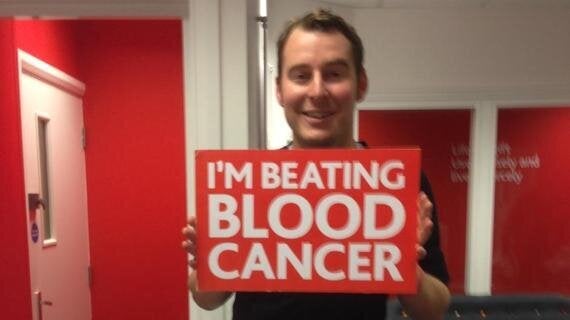
To this day, I cannot begin to describe how I felt when I got the news. There was still a long way to go and all manner of post-transplant related problems I could encounter, but in my head the leukaemia would no longer be the direct cause of my death. I had beaten leukaemia and I remember burst into tears of when this dawned on me. To my memory it was the only time I cried during my stay in hospital.
Ten days later, I was released from the Hammersmith and allowed to return home. At this point, safe in the knowledge that I was home and my operation had been a success, my Mum slipped into a coma. She died peacefully in her sleep four days later.
I cannot begin to thank the doctors and nurses at the Hammersmith enough for helping my mum live long enough to see me home - it was her final wish - and I will forever be in their debt for everything that they did for us.
Life after treatment
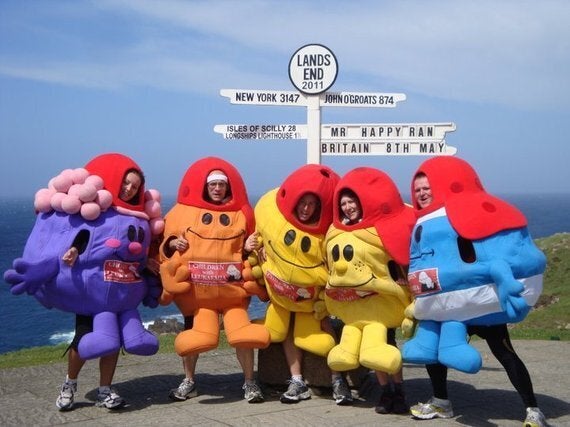
Since my transplant I've been able to do some pretty extraordinary things like see the sunrise over Angkor Wat, run from John O'Groats to Land's End dressed as Mr Happy and appear on a TV game show.
None of these things would have been possible without the help of researchers and charities like Bloodwise who make this research possible thanks to their tireless efforts to fund the research and clinical trials that are making a difference to the lives of thousands of blood cancer patients and their families.
The emergence of Imatinib and it's subsequent variations over the past 10 - 15 years has revolutionised CML treatment and dramatically increased survival rates for CML patients. CML is now a type of cancer that in the vast majority of cases can be managed and it is rightly held up as one of blood cancer research's biggest success stories. Indeed if I had the choice all over again I would have opted to try Imatinib in the first instance rather than go for the transplant
However there is still so much more work to be done. Living with CML as the vast majority of patients now do is no walk in the park. Side-effects of treatment can be severe - not least the cramps and the lethargy which can be hugely debilitating. There is a huge psychological and emotional aspect that is so often overlooked and very often misunderstood.
That's why I urge any of you that have read this far and are still interested to find out more about CML and what you can do to help increase understanding and support for CML patients and their families by visiting the World CML Day website and finding out more about World CML Day: http://www.cmladvocates.net/world-cml-day-9-22